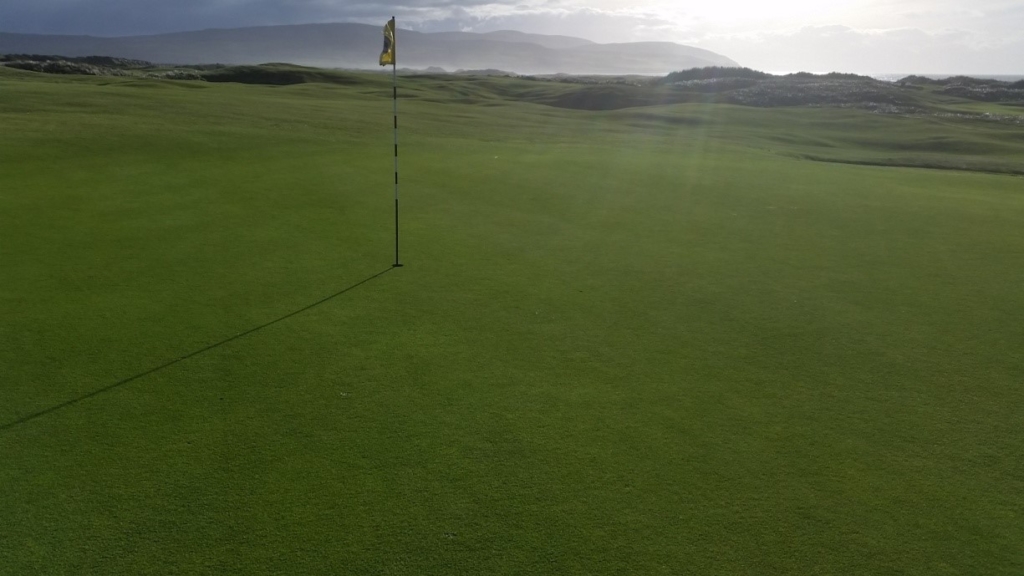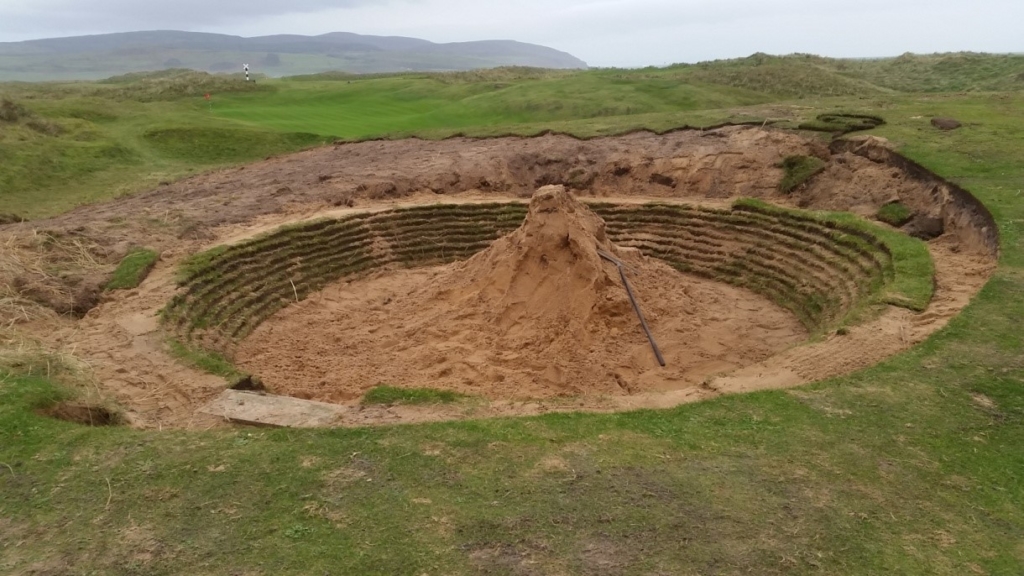I know it’s not like me, but I really haven’t got too much to say about October. I’m sure most of you who suffered through it with me would agree that the less we say about it, the better! It was the wettest and dullest month in recent memory, and probably the only positive we can take from it is that nearly all the fescue seeds we buried into the surface of our greens and tees have germinated and come to maturity without ever becoming even remotely dehydrated. We raised the mowing height on the greens after the Autumn Pairs to allow for recovery from the wear that inevitably accumulates during a typical golfing season–a time when we subject the grass to a near-death experience every single day in a relentless quest to provide players with tournament-level green speeds. Eventually, something has to give to ensure that we enter the harsh winter months with enough grass cover on even our weakest greens to avoid small bare patches from quickly turning into large bare patches. The decision to raise the cutting height slightly to give the greens a break while soil temperatures (and moisture levels!) were still relatively high has yielded good results. Although we remain constantly vigilant, we are quietly pleased with the recovery that we have seen over the last three weeks.

Balancing Turf Nutrition to Promote a Healthier Soil
Monitoring nutritional inputs is massively important at this time of year, as the threat of turf disease is never far away. We have been on the cusp of a fusarium outbreak for several weeks now, but have managed to keep our greens healthy enough to avoid the need to spray a remedial fungicide onto them. The longer I can maintain that position, the happier I will be. Not only are effective fungicides massively expensive, but they inevitably kill beneficial fungal bacteria as well as the bad guys that cause disease. Over-using these products would drag us into a negative spiral where we would need to constantly rely on them as a necessary component of our chemical arsenal rather than as a last resort. In an ideal world, our soil will be densely populated with all kinds of beneficial bacteria that break down thatch and turn it into plant food, protect plant cells from disease pathogens, and help the perennial grasses that we want to promote in our swards to form a positive bond with their rootzone that they are growing in. None of this would happen if sufficient colonies of these organisms were not present. In this situation, we would have to apply more artificial fertilisers than we would like, which would leave us open to attack from fungal outbreaks that could only be checked by reaching for artificial cures. We want our soil to contain natural predators that have the instincts to control those pathogens. Relying on chemistry alone would result in us working within a massively expensive and highly stressful vacuum in which everything we grow would only do so because of the applications we make. We don’t want that. Balancing chemistry with biology helps us avoid creating the kind of stressful environment that could negatively impact the health of the organisms that we rely upon to do our job for us. I was taught very early in my career that successful and cost-effective greenkeeping is entirely dependent on this good working balance between chemistry and biology. The longer I work at the seaside, the more I believe this is absolutely true. Unfortunately, so many of the things we do in our quest to provide golfers with consistently good playing conditions compromises the health of the grass and the soil that it grows in, which is, of course, why you see us running around making regular applications to the greens. But you hardly ever see us do anything to the outlying areas of the course where grass grows quite happily despite seeing very little maintenance. There is a direct correlation between the amount of stress that we subject an area of grass to and the amount of investment and effort it takes to keep that area of grass alive!
My goal at this time of year is to work with my soil analysis results and interpret what I see on a daily basis, then apply just enough of the exact nutrients that our greens need in order to go into December (gale season!) in perfect health. Apply too little or keep the height of cut too low and recovery before winter arrives will be too slow, leading to bare patches that will grow at a horrific pace with every salt-laden westerly wind that batters the course. Apply too much or aerate too little, or miss an opportunity to remove a dew that has settled on leaf blades, and a disease attack will smash through the overly-lush grass, forcing us to crack open the fungicide and send us right back to square one. Creating something that appears to be entirely natural is, in reality, all one big, complicated balancing act!

Winter Projects
The absolute best thing about our job is the way our tasks on the course fluctuate with the seasons. Spring revolves around preparing for the golfing season; summer is basically all about cutting grass and producing the best possible playing surface; autumn is about relieving the negative effects of what we do in summer, while winter — well, winter is mostly about regular aeration and construction. Last winter, we rebuilt a lot of bunkers with the aim to make them fairer and easier to play from. Eventually, we ran out of both time and turf, so we still have half of this project left to complete this winter. Being able to step back and see how the bunkers we built worked in practice and how they were received by guests and members has worked in our favour though, because although we have received a lot of good feedback about them, there is no doubt that some have not performed as well as we would have liked. The change of style was so drastic that I will admit, I compromised the design of some bunkers. The compromised ones are the ones that have suffered from excessive wind erosion and turf damage. There is no need for me to go into the technical details of how I think we can do better this next time around, but studying the progress of the ones we built last winter has definitely taught me some lessons that should ensure the ones we construct this year will work out a lot better.

The other job we are carrying over from last year is the replacement of all the wooden bridges on the course, except for the long boardwalk at the 17th. The wooden bridges were an attractive feature, but now, well, let’s just say they’ve seen better days. We were faced with the choice of either rebuilding them in a similar manner or changing the style to something a little less “eye-catching.” The design we came up with was very simple, and just involves burying a plastic culvert pipe under sand and turf and overlaying this with a pathway of rubber matting to help reduce wear from foot and machine traffic. As with all the construction jobs that we undertake on the course, the design of the bridges was carefully considered with environmental impact in mind. We still work within the parameters of an agreed management plan that was drawn up in conjunction with Scottish Natural Heritage and we are, therefore, always mindful that anything we do on the course must have minimal impact on the long-term integrity of the site. We feel that these bridges are actually an improvement in this regard, as the wooden ones provided a dark, humid environment that favoured the growth of weeds like dockens, nettles, and bracken over grass plants that need more light in order to compete effectively.
If you have any questions about the jobs that we are undertaking this winter, or if you have any suggestions for projects that you think we should consider in order to improve the way the course plays, then please come out and see us. Because of the strict environmental parameters that we work within, there may be reasons why we cannot tackle a project that would improve the way the course plays, but on many occasions, the reason why we have not done something that may seem obvious is simply because we have not spotted it. We look forward to seeing as many of you out there as possible over the winter months, making the most of the sunny days that we must surely be due after the poor weather we have had to endure for the last five months!
Enjoy your golf!

